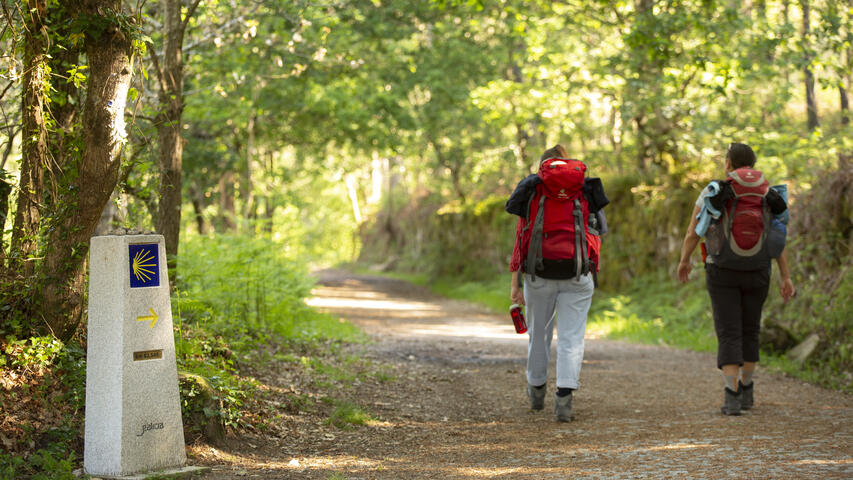The symbols of the way of St. James
Walking the way of St. James is an experience that goes far beyond covering kilometers: it entails a profound personal, spiritual, cultural, and social transformation.
The Jacobean route has its roots in the Middle Ages, when Christians began their pilgrimages to the tomb of the Apostle James in Compostela, making it one of the three great Christian pilgrimage routes alongside Rome and Jerusalem.
The Way also serves as a metaphor for life: a journey filled with challenges, discoveries, encounters, and learning. It fosters reflection, detachment from material things, and connection with oneself.
Regardless of its Christian origin, it is a transformative experience that becomes a vital milestone.
Several Jacobean routes converge in the Rías Baixas region: the Central Portuguese Way, the Portuguese Coastal Way, the Vía de la Plata, the Winter Way, and the Sea of Arousa Route, as well as other variants such as the Father Sarmiento Route, the Geira and Arrieros Route, and the Marian Way. Along these paths, one may encounter many recurring symbols of the Camino.
The scallop shell is undoubtedly the most universal icon of the entire the Way of St. James.
According to an ancient medieval legend, when the body of the Apostle James was transported by sea to Galicia, a storm capsized the boat and a knight fell into the sea. He was miraculously rescued, covered in scallop shells. Since the Middle Ages, pilgrims who arrived in Compostela would collect a shell from the Galician coast as proof of having completed the pilgrimage.
Today, the shell symbolizes the convergence of many paths into one final destination: Santiago de Compostela. It has become a hallmark of the pilgrim’s identity—a living symbol of faith, effort, and spiritual encounter.

The yellow arrows indicate the correct direction of the Way St. James and have become a common symbol and visual identity for all the routes.
Their origin is relatively recent but highly meaningful. In the 1980s, Father Elías Valiña Sampedro, a parish priest from O Cebreiro, decided to personally mark the Camino to help pilgrims find their way, at a time when the route was in decline and poorly signposted. He painted the first yellow arrows with industrial spray paint for a practical reason: the yellow color is highly visible both day and night and stands out against the rural Galician landscape.
Today, the yellow arrows serve a functional role, offering guidance and reassurance to the pilgrim.

The Cross of Saint James, also known as the sword cross, is one of the oldest and most emblematic symbols of the Camino de Santiago and of the military-religious Order named after the Apostle. Its history is deeply connected to the Apostle James the Greater and the historical context of the Christian Reconquista of the Iberian Peninsula.
Its shape is said to derive from a Latin cross in the form of a sword, with the arms shaped like fleur-de-lis, honoring the Apostle’s purity. Traditionally red, it symbolizes the blood of martyrdom.
Today, it is the official emblem of the Order of Santiago, visible on coats of arms, churches, monasteries, Jacobean milestones, and ceremonial uniforms. It represents spiritual guidance, protection, identity, and devotion for pilgrims.

The pilgrim's staff, also known as a bordón, is one of the most recognizable elements of traditional pilgrim attire. More than just a walking aid, the staff carries multiple symbolic, practical, and historical meanings.
Since the earliest centuries of pilgrimage, the staff has served as a tool for support and protection. It is often accompanied by a gourd, used as a rudimentary water container, and a small bell to announce the pilgrim’s presence in villages or shelters.
The staff is much more than physical support: it symbolizes strength, faith, and humility. It sustains the walker on their path and serves as a reminder that each step is progress on the journey toward oneself, toward Santiago... and toward something greater.

While all Caminos share universal symbols such as the scallop shell and yellow arrow, there are also distinctive elements that help differentiate each route and reinforce its identity:
- Portuguese Way and Portuguese Coastal Way
Stone markers with a blue shell and yellow arrow.
In urban areas, metal plaques embedded in the pavement indicate the route.
Occasionally, a Celtic cross may appear.
- Winter Way
Often uses a combination of shell and mountain motifs, reflecting its mountainous terrain.
- Vía de la Plata
The Cross of Saint James may accompany yellow arrows.
Some areas feature markers or signs on stone slabs, evoking the ancient Roman road.
- Sea of Arousa Route
The shell may be accompanied by the symbol of a boat, referring to the Traslatio, the only maritime route.
The pilgrim is the ultimate symbolic figure of the Camino de Santiago. Their image, rich in spiritual, historical, and cultural significance, represents far more than someone simply walking: it embodies a journey of searching, transformation, and transcendence.
The pilgrim is not merely a traveler to Santiago—they are the living symbol of the Camino itself. They represent the soul in search, the human being in transit, and their image has been forever associated with the enduring values of humility, perseverance, transformation, and hope.
